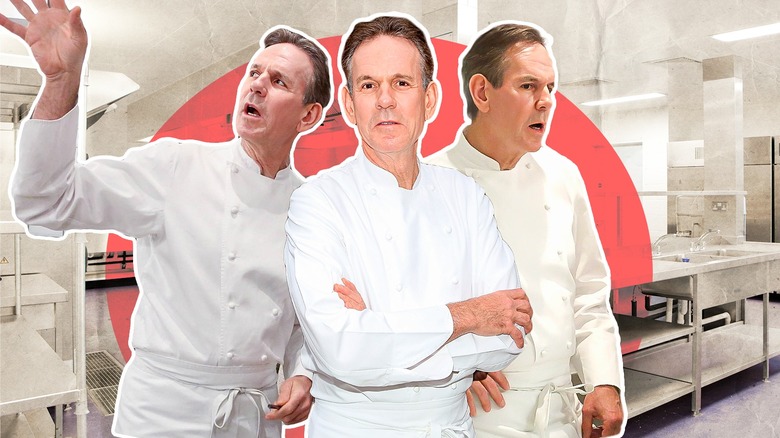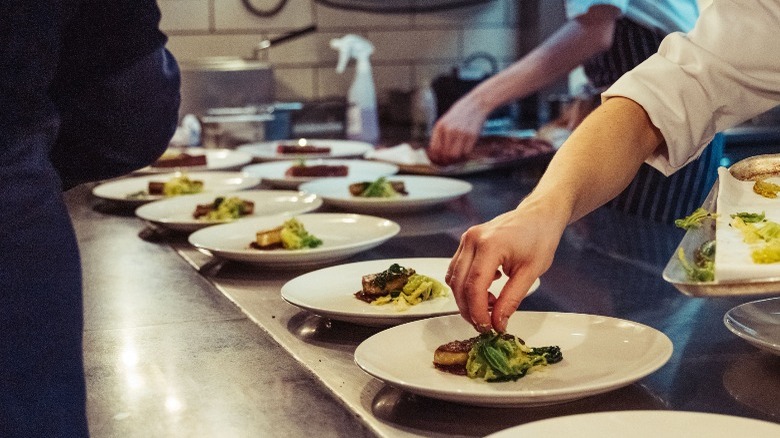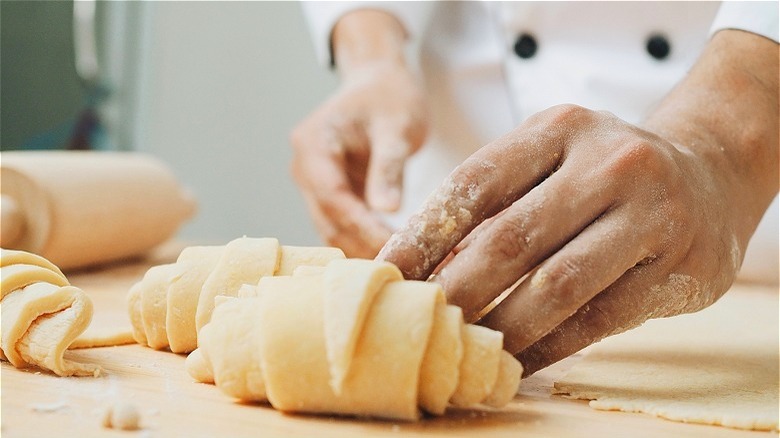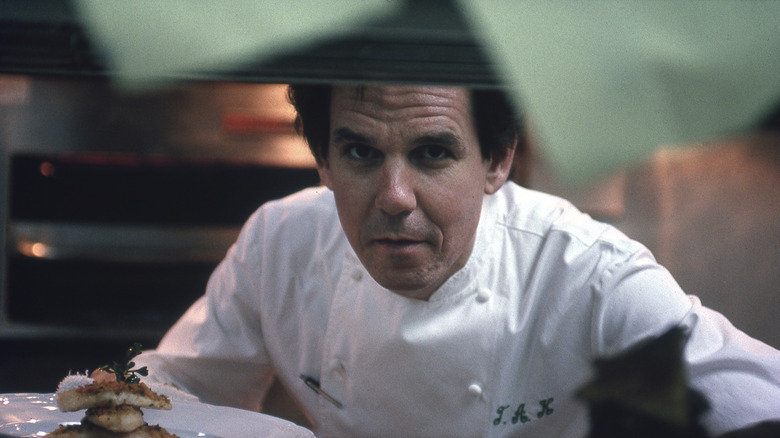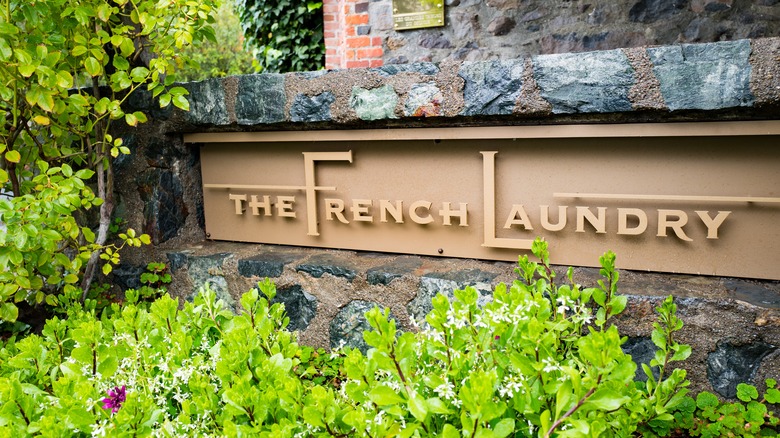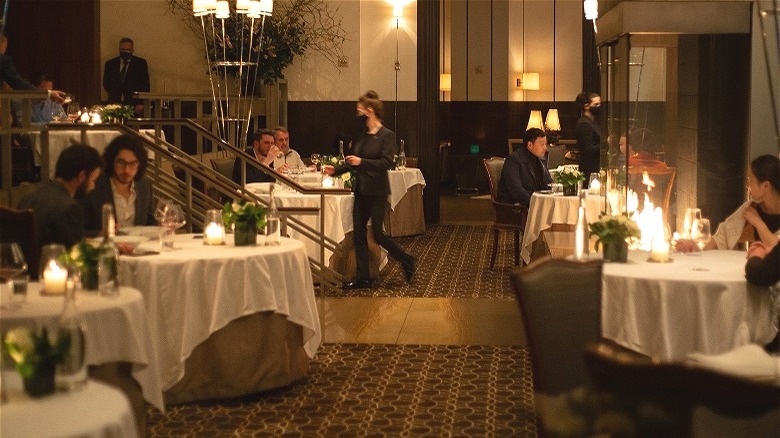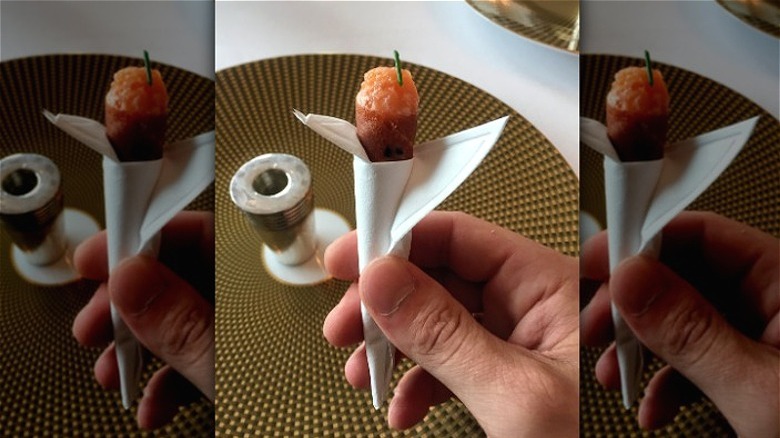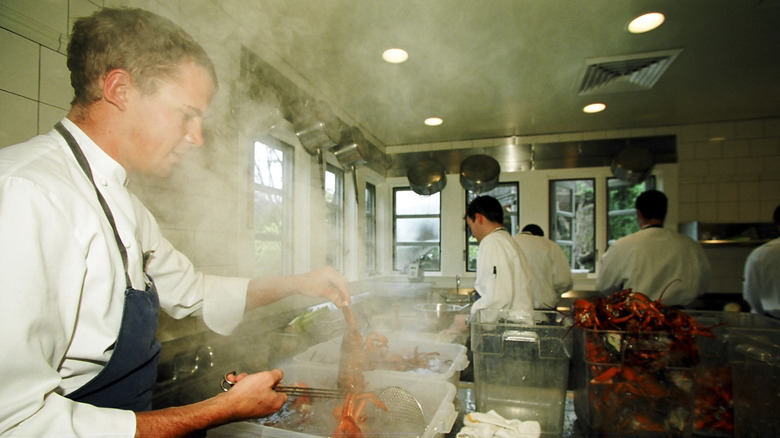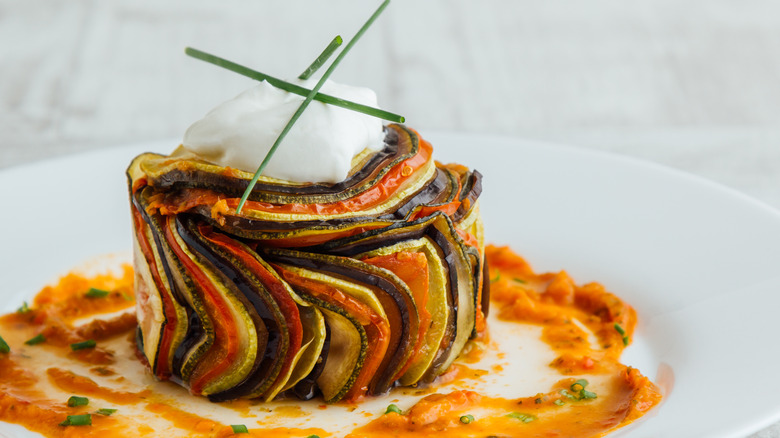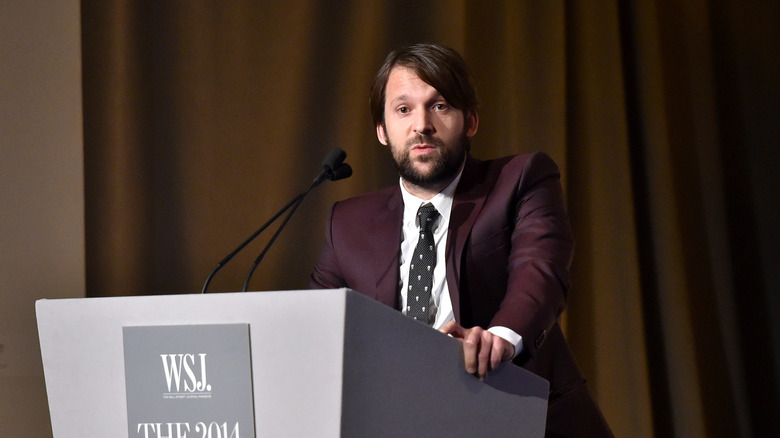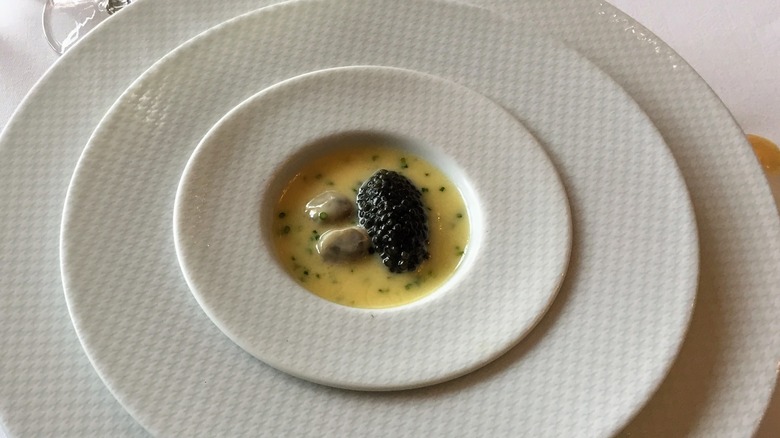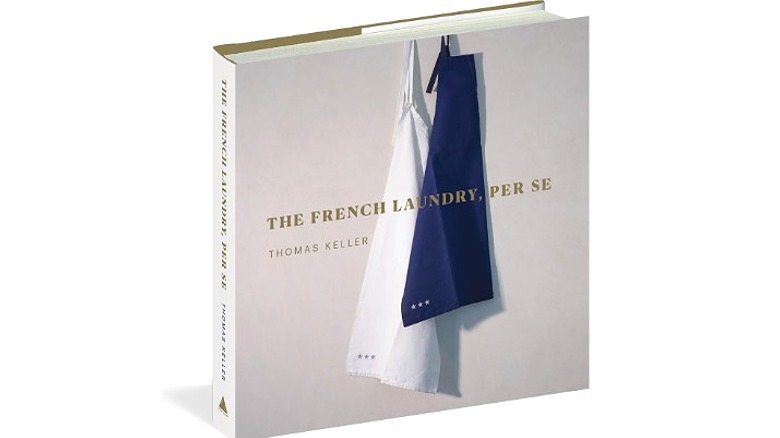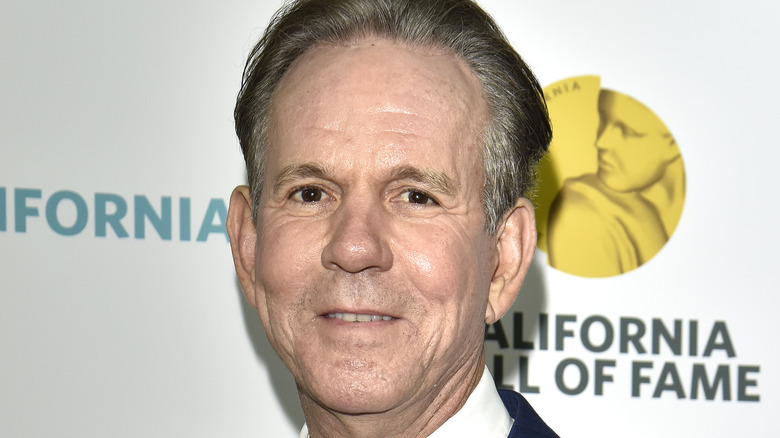Everything You Need To Know About Legendary Chef Thomas Keller
Few American chefs have a legacy to rival that of Thomas Keller. His has been a legendary career spanning more than four decades. During this time, Keller has mentored and worked alongside the most celebrated chefs of multiple generations, while accruing a huge array of personal achievements. To put it simply, he has irrevocably changed American fine dining forever.
As with all immensely successful chefs, Keller's career has not been one of unrelenting success. There have been challenges along the way; missteps and setbacks, too. Keller has accepted both the highs and the lows with steadfastness and willingness to learn. This, above any innate talent or inherent technical skill, explains his astounding success.
If grit and determination are words that define Keller's career, elegant and refined are the two most frequently used to describe the restaurants that have arisen from it. This juxtaposition is just one of the numerous fascinating realizations concerning Keller's career. Several more are detailed below.
He worked his way up through the ranks of professional kitchens
Thomas Keller was born to a father who was enrolled in the Marines and a mother that managed a restaurant. While the former may have instilled discipline into Keller from a young age, his mother shaped his life more. Keller's mother was also the one who introduced him to the kitchen, securing him a job as a dishwasher that would spark his love for professional kitchens.
Keller's first cooking job came in 1974 when he worked at the Palm Beach Yacht Club. He followed this up with a move to Rhode Island, where he did a stint at a country club under the tutelage of legendary chef Roland Henin. The French-born Henin would go on to mentor several notable American chefs, including Keller.
Another legendary chef, Daniel Bouloud, explained the impact this mentorship had on Keller to 50 Best: "He had a mentor who was French, Roland Henin, who was almost a scholar of cooking, and Thomas always felt French cuisine was a living, breathing cuisine with respect for seasonal ingredients and complexity." Keller's respect and understanding for the evolving nature of French cooking has been evident throughout his career, especially in his flagship restaurant The French Laundry.
He spent time working in France
Like many chefs before him, Thomas Keller found the pull of Europe too alluring and moved to France in 1983. He worked for short stints in some of Paris' most iconic restaurants, two of which — Guy Savoy and Le Taillevent – have maintained their excellence to this day. In these kitchens, Keller learned the dishes and techniques that would form the basis of his culinary style.
While just a few years long, Keller's time in France cemented his love for the country's cuisine. This is a love Keller never lost, as he highlighted in an interview with the Institute of Culinary Education: "It's really the flavor profiles that the French have established that make it very important for me. I love the definition of the plates, how they are composed. In French cuisine, you would have a sauce. You would have a protein. I just like that. It doesn't always happen in cuisine."
One of his first restaurants was only open for four years
After returning from France, Keller felt ready to express his own culinary creativity. To do so he paired with Serge Raoul, one of New York's restaurateurs. The resulting restaurant, Rakel, opened in 1986. Rakel was very inventive for its time, bucking the bistro trend that was sweeping across the United States.
Although nascent, Keller's cooking at Rakel grabbed attention, namely for his masterful ability to create contrasting textures. Keller was already delivering unexpected flavors in familiar packages. Unfortunately, a trend took over in the 1980s in which many restaurants moved away from fine dining. Raoul was eager for Rakel to do the same. This ultimately resulted in Keller leaving. The restaurant was renamed and restyled shortly after.
Keller spoke about leaving Rakel to The New York Times: "The management was not as strong as it should have been. The restaurant was undercapitalized, and we didn't capitalize on great reviews. Financially it wasn't working, and Serge Raoul wanted to run Rakel like Raoul's, like a bistro. I didn't want to compromise what I was cooking and realized I would have to make a change. It was heartbreaking, confusing. It was torture. I was sad, depressed, embarrassed. Now I feel it was a great accomplishment to gain that experience at that age."
The French Laundry changed fine dining forever
After leaving Rakel, Thomas Keller tried his hand at running an olive oil business, but deep down he was set on opening another fine dining restaurant. He found it in Napa Valley's The French Laundry.
Contrary to common belief, The French Laundry existed before Thomas Keller bought it; the restaurant was first opened by Sally and Don Schmitt in 1978. This early iteration of The French Laundry was innovative, pioneering the set menu format in the Bay area alongside Alice Waters' Chez Panisse.
Keller bought the restaurant, with the backing of a host of investors, in 1994. Since this time, The French Laundry has stood as the ultimate fine dining establishment in America, being awarded three Michelin stars every year since the guide began reviewing the area in 2007. Keller's innovative reimagining of French classics using local — and often homegrown — produce, not only impressed the Michelin judges but signified a new standard in global fine dining.
This standard, which Keller has maintained for over 25 years, stays true to many traditional hallmarks of luxury, including pressed table linens and immaculate service. Yet, the playful, innovative food has always been at the center of the restaurant. It remains so to this day.
The French Laundry was given a green Michelin star
Thomas Keller has long been fixated on producing food in an environmentally sustainable manner. At The French Laundry, this is most evident through the sweeping three-acre garden that supplies the restaurant with fresh produce. This impressive feat, however, is just the tip of the iceberg.
Since 2004, Keller has been making environmentally-minded improvements to The French Laundry. He detailed these in an interview with Barrons: "We almost gutted it and rearranged the entire kitchen, installing a geothermal loop system for all of our hot water, refrigeration, and heating to try and embrace and exemplify a restaurant that's trying to be more sustainable and represent for generations to come that these things are possible."
In 2014, The French Laundry underwent a $10 million renovation. While changes were made for many reasons, sustainability played a key factor. As a result, some roofs were covered in solar panels; these now supply 50% of the restaurant's electricity. Wood-clad buildings have even been treated with a Japanese burning technique known as shou sugi ban which negates the need for weather-resistant paints. This attention to detail has culminated in The French Laundry being awarded a Michelin green star, an award only given to restaurants that are leaders in sustainable gastronomy.
He is also known for his restaurant Per Se
The French Laundry is often cited as the best restaurant in America. Indeed, it was named the best restaurant in the world in both 2003 and 2004. For most chefs, this would be enough. Thomas Keller, however, wanted another challenge which came in the form of Per Se, a restaurant that opened in New York City in 2004.
Per Se cost $12 million to open and impressed critics with its own brand of Keller's inventive, exquisitely executed food. This cooking has its roots in the chef's notorious attention to detail, which is evidenced through the design of the entire restaurant, especially in the kitchen. Keller explained some of the more irregular features, including ambient lighting and tablecloth-covered workbenches, when interviewed by The Splendid Table: "When we're plating our food, we want to see it the same way our guests see it. The other thing that you'll notice here is we have all incandescent lighting, there's no fluorescent lighting. It's very specific lighting designed to spot each different area as well as the workstations. It gives us the opportunity to see the food exactly as our guests see the food. That's very important for us."
Unsurprisingly, Per Se was an immediate hit, although some thought the early services to be somewhat vain – as the result of the overworked presentation and wordy descriptions. The restaurant soon evolved and really hit its stride during the early 2010s under head chef Eli Kaimeh.
He is the only American-born chef to be awarded three Michelin stars at two restaurants
Although it was opened later than The French Laundry, Per Se was the first to be awarded three Michelin stars. This honor came in 2006, the first year the Michelin Guide reviewed restaurants in the New York area. As previously mentioned, The French Laundry received the same honor during the Bay Area's inaugural year in the Michelin Guide, 2007. Since this time, Keller has been the only chef based in the United States to simultaneously run two three Michelin-starred restaurants.
Many expected the launch of Per Se to coincide with a drop in quality at The French Laundry. Although The French Laundry did close for four months for staff to be trained at Per Se, a lowering in quality didn't materialize. Again, this is thanks to Keller's attention to detail. He has been known to regularly fly from coast to coast in order to ensure both restaurants are running smoothly. Keller even installed closed-circuit TV's in both his restaurant's kitchens so he can stay up-to-date with both restaurants' services in real time.
Despite having held three stars at his two establishments for years, Keller never takes them for granted, as he highlighted to The Michelin Guide: "Receiving three Michelin stars is a huge responsibility—you have to bear that responsibility with strength, conviction, determination, and commitment, and your whole team has to do that every night. You're representing over 100 years of history."
His restaurants serve icebreakers at the start of the meal
Thomas Keller is aware that dining in his high-end restaurants can be a strange, even intimidating, experience. That's why the first food he serves is always a playful appetizer that breaks the ice. Keller explained this to NPR: "It's a way of opening up. Somebody comes to the restaurant, they're at the French Laundry or they're at Per Se, and, you know, sometimes those kind of restaurants can be a little intimidating, right. And so we want to kind of break the ice. And what better way to break the ice then to give them something that looks like an ice cream cone. If you don't smile at that, then you have no sense of humor whatsoever."
As Keller mentioned, his favored ice breaker is salmon cornets, appetizers that are shaped like an ice cream cone. The "scoop" that fills the small cone is made from salmon tartare and crème fraiche, topped with chives.
His famous restaurants have had some poor reviews
The French Laundry and Per Se are giants in American gastronomy; hallowed establishments that form the basis of many epicure's bucket lists. Their reputation precedes them, but not all diners believe their experience lives up to the billing.
The most famously disenfranchised guest is Pete Wells, current food critic of The New York Times. In a 2016 review, Wells' lampooned Per Se, demoting it from the publication's maximum four stars to a sheepish two. Criticisms from other outlets followed.
Keller was accepting of the criticism, stating to Town and Country: "Maybe we were complacent. I learned that, maybe, as a team we were a little bit too arrogant, our egos too exposed." Soon after the Wells review, Per Se parted ways with head chef Eli Kaimeh. Sous chef Corey Chow took his place and has since rebuilt the restaurant's reputation.
The French Laundry has not been free from bad reviews either. In October 2022, Soleil Ho — a review for the San Francisco Chronicle — criticized the restaurant as serving unremarkable, bland dishes. The Infatuation followed suit in early 2023, scoring the restaurant an embarrassingly low rating of 6.3 out of 10. This suggests that Keller's reign as America's most celebrated chef may be in peril.
He was a consultant for the film Ratatouille
In 2007, "Ratatouille", an animated film about a culinary-inclined rat, was released by Pixar. The movie received overwhelmingly positive reviews, with critics citing beautiful animation, a cliché-free storyline, and good casting as its primary attractions. Important as these previous components are, the most impressive of all is the film's accurate portrayal of professional kitchens.
Thomas Keller had a key role in assuring the gastronomic authenticity of "Ratatouille." The star chef was hired by Pixar as a consultant, giving his insight into the culinary aspects of the film. This involved Keller designing a menu for the film. Keller even had a hand in the film's cumulative scene, where critic Anton Ego is transported back to his childhood by a single dish.
Keller explained the idea behind that scene to The New York Times: "We had to think about what would make the food transformed. What would transport him back to his childhood in a Proustian sort of way. When I picked up a layer of the byaldi and it compacted, I realized at that moment how the dish would come together." The resulting scene is one of the most iconic in Pixar's storied history.
He is a renowned mentor
Thomas Keller has a great many achievements to his name. While others may grab more attention, Keller's greatest impact on gastronomy has been his tireless and patient mentoring of professional cooking's brightest stars. The most famous of Keller's mentees is René Redzepi, the founder of Noma. Numerous other Michelin-starred chefs also developed their craft under Keller.
For Keller, mentoring is not about training people to stay at his restaurants; it's a way of improving the profession as a whole. He explained this notion to FSR Magazine: "We know they're not going to be with us forever. Our profession is what we need to be thinking about. If we all thought about it that way, the new individuals coming in would also be well prepared. It's a profession and we need to stand shoulder to shoulder and help each other out."
The influence of Keller's mentoring extends past those that were under his direct tutelage. This is because the attitudes instilled in his mentees have been further dispersed, as individuals like Redzepi take on mentees of their own. Consequently, it's no exaggeration to say Keller has influenced thousands of chefs.
The chef has one signature dish
For better or worse, all famous chefs come to be associated with one dish in particular. St John's Fergus Henderson is known for his roast bone marrow and parsley salad. For Marcus Samuelsson, it is a dish known as the Swediopian. Thomas Keller's signature dish is called "Oysters and Pearls," a dish that has been featured on the menus of The French Laundry and Per Se for years.
The dish includes two oysters covered in a sabayon of pearl tapioca and a mound of caviar. The short ingredient list is brought together through a myriad of delicate and complicated techniques to produce what some have called one of the greatest dishes of all time.
Throughout the ups and downs of all his restaurants, Keller's signature dish has stood firm, consistently winning praise for its ingenuity and execution. This has been no surprise to Keller himself, as he stated with characteristic confidence to The Independent: "Certain things you just know. It's all just logical."
The recipes in his cookbooks are notoriously complex
The food served at Thomas Keller's restaurants is known for being intensely flavorful and technically astounding. As with all good art, the polished, beautiful presentation belies the numerous, complex processes it took to create the dishes. These processes are exposed in Keller's published cookbooks, several of which celebrate and defend fine dining in all its complexities.
Keller published "The French Laundry Cookbook" in 1999. None of the recipes in this book were simplified to accommodate home cooks' skill levels or their limited working environments. Nonetheless, the book found an audience.
Even in 2020, with the world in the grip of the coronavirus pandemic, Keller did not budge from his creed of no simplification. During this time, he published "The French Laundry, Per Se," another extremely complex cookbook. Although many recipes in this most recent book are unattainable for all but the most skilled home cooks, Keller insisted in an interview with Sunset that everyone could take something from its pages: "In the book we have the liaisons [sauces] and vinaigrettes which are based on ratios. These are things a home cook can get comfortable with and understand with repetition and in turn make their own recipes."
He has not slowed down in recent years
At the time of writing, Thomas Keller is 67 years old. Traditionally, chefs have wound down their careers when in their sixties, whether by choice or due to the wear and tear of the profession taking its toll. Yet, Keller has shown no signs of slowing down in recent years. He currently has plans to open new restaurants in Miami, while also maintaining standards at his other establishments.
Keller's continued insistence to perpetuate the breakneck pace that has defined his career is surprising, especially as he seemed ready to retire a few years ago. Speaking to The New York Times in 2017, Keller said: "I go back and forth on the level of intensity I want to continue to dedicate to my profession because I've done it now for the past 44 years, and that's a long time. When is taking care of everybody else less important than taking care of yourself?"
Given his current projects, it would seem he remains tied to his craft and is eager to continue contributing to America's flourishing gastronomic scene. This is something the entire culinary world can be grateful for.
